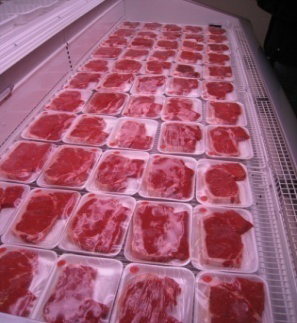Project Summary
The Impact of Post-Harvest Interventions on the Color Stability, and Subsequently, the Palatability, of Beef from Cattle Fed Wet Distiller’s Grains
- Principle Investigator(s):
- S. Knobel, D. VanOverbeke, G. Hilton, & B. Morgan
- Institution(s):
- Oklahoma State University
- Completion Date:
- May 2009
Background
Existing data at the University of Nebraska (Calkins, 2007) and Oklahoma State University (unpublished data) indicates that oxidation increases and color deteriorates faster in steaks from cattle fed increasing levels of wet distiller’s grains. Increasing fuel ethanol production has led to an increase in distiller’s grains availability across the country. Since color is an important factor in consumer purchasing decisions, it is important to determine the impact of potential post-harvest interventions on maintaining color stability, and subsequently, the palatability of steaks processed using these interventions.
- Determine the impact of using post-harvest interventions on the color stability of beef products from cattle that have been fed wet distiller’s grains.
- Determine the impact of the post-harvest interventions on the palatability of beef steaks after they have been under retail display for at least three days.
Methodology
Two hundred and forty heifers were assigned to one of two treatment groups: dry rolled corn (DRC), the control group; or 30 % wet distiller’s grains plus solubles (WDGS). Carcass data were collected at a commercial harvest facility.
Sample preparation, striploins
Half of each pair of strip loins selected from these two treatment groups was injected with an enhancement solution while the other half was cut directly into steaks without enhancing. The face steak was collected and frozen for pre-display thiobarbituric acid reactive substance (TBAR) analysis. Steaks were cut and identified for either modified atmosphere packaging (MAP) or polyvinyl chloride (PVC) Warner-Bratzler shear force (WBSF) analysis, MAP or PVC full retail display, MAP or PVC three-day retail display, MAP one-day display or TBAR analysis. MAP products were placed in dark storage for five days, while all PVC products were immediately placed under retail lighting.
A trained panel evaluated color subjectively on muscle color score, surface discoloration and overall acceptability for 120 hours. Objective color was evaluated by measuring each steak to determine color values for brightness, redness/greenness and yellowness/blueness at time of initial retail display, one day, three days and five days. Steaks were then removed from the case at five days and frozen for WBSF, sensory panel or TBAR analysis. Lipid peroxidation was determined by a modified method of Buege and Aust (1978). Steak cores for WBSF analysis were sheared using the Instron Universal Testing Machine. Sensory panelists scored steaks for juiciness, tenderness and connective tissue amount, and for beefy, painty/fishy, livery/metallic and salty flavors.
Sample preparation, ground beef Chuck rolls were ground; four samples of ground beef were packaged using PVC and the four samples were packaged under MAP. MAP products were placed in dark storage for five days, while all PVC products were placed immediately under retail lighting. Ground beef products were color-scored on ground meat color and discoloration in the same manner as steaks. At the end of the five-day period, ground beef was removed from the retail case and frozen for later TBAR analysis. Sensory analysis was also evaluated in the same manner as steaks for three flavor profiles: beef flavor, painty/fishy flavor and livery/metallic flavor.
Findings
Significant interactive effects are displayed in Table 1. The non-enhanced MAP steaks contained the most significant differences between dietary treatments. Otherwise, comparing treatment groups, non-enhanced products oxidized more quickly (P < 0.05) than enhanced with the exception of PVC steaks removed on day three of retail display. If comparing only treatment to control, without taking enhancement into effect, WDGS MAP steaks were significantly brighter, redder and more yellow on all three days of readings than control steaks. Concerning ground beef, PVC products did exhibit a darker color and more discoloration than MAP products when removed from the case. When packaged under MAP, WDGS ground beef was less beefy and more painty-flavored than control ground beef. Sensory panelists also found control ground beef was more livery than WDGS ground beef overall.Table 1. Significant results of interactions between packaging method and enhancement in steaks
|
Treatments |
Objective color (5d) |
Subjective color (5d) |
Sensory Traits |
|
Enhanced MAP |
Control steaks brighter |
WDGS discolors more than control |
---- |
|
Non-enhanced MAP |
WDGS redder and yellower than control |
---- |
Control steaks juicier |
|
Non-enhanced PVC |
---- |
---- |
WDGS juicier, more tender, and less connective tissue than control |
Implications
Results indicate that MAP packaging, but not enhancing, products from cattle fed 30% WDGS may be the best way to maintain a visually appealing appearance in the retail case, but at a possible risk to product juiciness. If enhanced and MAP packaged, the distiller’s-grain-fed product did not appear to be able to maintain visual appearance in the retail case like the control product. Visual appearance of ground beef seemed to be positively impacted by using the MAP method of packaging, but the product tasted more oxidized and less beefy to panelists. Further research is needed to determine the best combination of post-harvest interventions to preserve color and palatability in beef from cattle fed WDGS.

References
-
Calkins, C. 2007. Impact of distillers grains on meat quality. Presented at the BEEF Magazine Beef Quality Summit, Omaha, NE, November 2007.